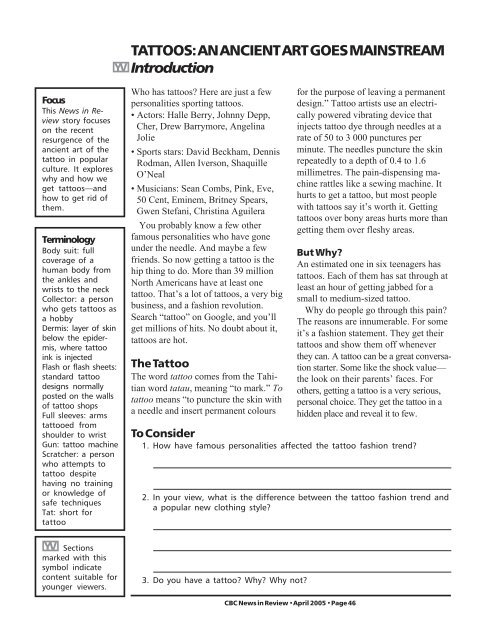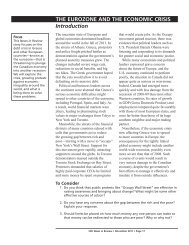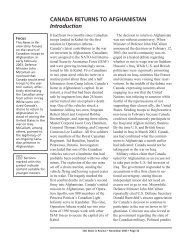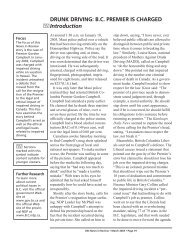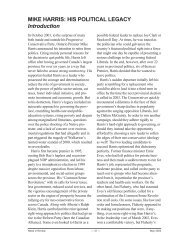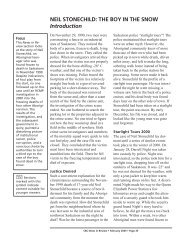TATTOOS: AN ANCIENT ART GOES ... - News in review
TATTOOS: AN ANCIENT ART GOES ... - News in review
TATTOOS: AN ANCIENT ART GOES ... - News in review
You also want an ePaper? Increase the reach of your titles
YUMPU automatically turns print PDFs into web optimized ePapers that Google loves.
Focus<br />
This <strong>News</strong> <strong>in</strong> Review<br />
story focuses<br />
on the recent<br />
resurgence of the<br />
ancient art of the<br />
tattoo <strong>in</strong> popular<br />
culture. It explores<br />
why and how we<br />
get tattoos—and<br />
how to get rid of<br />
them.<br />
Term<strong>in</strong>ology<br />
Body suit: full<br />
coverage of a<br />
human body from<br />
the ankles and<br />
wrists to the neck<br />
Collector: a person<br />
who gets tattoos as<br />
a hobby<br />
Dermis: layer of sk<strong>in</strong><br />
below the epidermis,<br />
where tattoo<br />
<strong>in</strong>k is <strong>in</strong>jected<br />
Flash or flash sheets:<br />
standard tattoo<br />
designs normally<br />
posted on the walls<br />
of tattoo shops<br />
Full sleeves: arms<br />
tattooed from<br />
shoulder to wrist<br />
Gun: tattoo mach<strong>in</strong>e<br />
Scratcher: a person<br />
who attempts to<br />
tattoo despite<br />
hav<strong>in</strong>g no tra<strong>in</strong><strong>in</strong>g<br />
or knowledge of<br />
safe techniques<br />
Tat: short for<br />
tattoo<br />
YV<br />
Sections<br />
marked with this<br />
symbol <strong>in</strong>dicate<br />
content suitable for<br />
younger viewers.<br />
YV<br />
<strong>TATTOOS</strong>: <strong>AN</strong> <strong>AN</strong>CIENT <strong>ART</strong> <strong>GOES</strong> MAINSTREAM<br />
Introduction<br />
Who has tattoos? Here are just a few<br />
personalities sport<strong>in</strong>g tattoos.<br />
• Actors: Halle Berry, Johnny Depp,<br />
Cher, Drew Barrymore, Angel<strong>in</strong>a<br />
Jolie<br />
• Sports stars: David Beckham, Dennis<br />
Rodman, Allen Iverson, Shaquille<br />
O’Neal<br />
• Musicians: Sean Combs, P<strong>in</strong>k, Eve,<br />
50 Cent, Em<strong>in</strong>em, Britney Spears,<br />
Gwen Stefani, Christ<strong>in</strong>a Aguilera<br />
You probably know a few other<br />
famous personalities who have gone<br />
under the needle. And maybe a few<br />
friends. So now gett<strong>in</strong>g a tattoo is the<br />
hip th<strong>in</strong>g to do. More than 39 million<br />
North Americans have at least one<br />
tattoo. That’s a lot of tattoos, a very big<br />
bus<strong>in</strong>ess, and a fashion revolution.<br />
Search “tattoo” on Google, and you’ll<br />
get millions of hits. No doubt about it,<br />
tattoos are hot.<br />
The Tattoo<br />
The word tattoo comes from the Tahitian<br />
word tatau, mean<strong>in</strong>g “to mark.” To<br />
tattoo means “to puncture the sk<strong>in</strong> with<br />
a needle and <strong>in</strong>sert permanent colours<br />
CBC <strong>News</strong> <strong>in</strong> Review • April 2005 • Page 46<br />
for the purpose of leav<strong>in</strong>g a permanent<br />
design.” Tattoo artists use an electrically<br />
powered vibrat<strong>in</strong>g device that<br />
<strong>in</strong>jects tattoo dye through needles at a<br />
rate of 50 to 3 000 punctures per<br />
m<strong>in</strong>ute. The needles puncture the sk<strong>in</strong><br />
repeatedly to a depth of 0.4 to 1.6<br />
millimetres. The pa<strong>in</strong>-dispens<strong>in</strong>g mach<strong>in</strong>e<br />
rattles like a sew<strong>in</strong>g mach<strong>in</strong>e. It<br />
hurts to get a tattoo, but most people<br />
with tattoos say it’s worth it. Gett<strong>in</strong>g<br />
tattoos over bony areas hurts more than<br />
gett<strong>in</strong>g them over fleshy areas.<br />
But Why?<br />
An estimated one <strong>in</strong> six teenagers has<br />
tattoos. Each of them has sat through at<br />
least an hour of gett<strong>in</strong>g jabbed for a<br />
small to medium-sized tattoo.<br />
Why do people go through this pa<strong>in</strong>?<br />
The reasons are <strong>in</strong>numerable. For some<br />
it’s a fashion statement. They get their<br />
tattoos and show them off whenever<br />
they can. A tattoo can be a great conversation<br />
starter. Some like the shock value—<br />
the look on their parents’ faces. For<br />
others, gett<strong>in</strong>g a tattoo is a very serious,<br />
personal choice. They get the tattoo <strong>in</strong> a<br />
hidden place and reveal it to few.<br />
To Consider<br />
1. How have famous personalities affected the tattoo fashion trend?<br />
2. In your view, what is the difference between the tattoo fashion trend and<br />
a popular new cloth<strong>in</strong>g style?<br />
3. Do you have a tattoo? Why? Why not?
Complete all questions<br />
<strong>in</strong> while<br />
<strong>review</strong><strong>in</strong>g the<br />
video.<br />
Did you know . . .<br />
The 5 000-year-old<br />
body of Oetzi “The<br />
Iceman”—found <strong>in</strong><br />
1991 <strong>in</strong> the Austrian<br />
Alps—had 57<br />
tattoos?<br />
At one time, Maori<br />
people embalmed<br />
the heads of dead<br />
relatives and<br />
prisoners of war?<br />
Europeans traded<br />
with the Maori for<br />
these heads, which<br />
they prized for<br />
their tattoos. The<br />
trade was f<strong>in</strong>ally<br />
stopped <strong>in</strong> 1831.<br />
The most tattooed<br />
men <strong>in</strong> the world<br />
are Tom Leppard of<br />
Scotland and Lucky<br />
Rich of Australia?<br />
Their bodies are<br />
99.9 per cent<br />
covered.<br />
One of the world’s<br />
two most tattooed<br />
women is Krystyne<br />
Kolorful—a Canadian?<br />
YV<br />
<strong>TATTOOS</strong>: <strong>AN</strong> <strong>AN</strong>CIENT <strong>ART</strong> <strong>GOES</strong> MAINSTREAM<br />
Video Review<br />
1. As you view the video, you’ll hear about many people who have tattoos.<br />
List the many walks of life from which they come.<br />
2. Why is the Borneo tattoo culture disappear<strong>in</strong>g?<br />
3. Where does the word tattoo come from? ______________________________<br />
4. What did Capta<strong>in</strong> Cook have to do with the history of the tattoo?<br />
5. How much does it cost to get a typical tattoo? __________________________<br />
6. What does about half of that pay for? _________________________________<br />
7. How long does it take to get a typical tattoo? __________________________<br />
8. How many tattoo shops are <strong>in</strong> Vancouver now?<br />
_________________________<br />
9. Accord<strong>in</strong>g to CBC reporter Dan Bjarnason, there are two basic philosophies<br />
of tattooism. What are they?<br />
10. Accord<strong>in</strong>g to V<strong>in</strong>ce Hemm<strong>in</strong>gson, men and women tend to get tattoos for<br />
different reasons. What are these reasons?<br />
11. What percent of Americans between the ages of 25 and 29 have at least<br />
one tattoo? ______ per cent<br />
12. Accord<strong>in</strong>g to renowned tattoo artist Lyle Tuttle, “Names aren’t smart.”<br />
What does he mean?<br />
13. What technology does Dr. Mart<strong>in</strong> Braun use to remove tattoos?<br />
14. How much more expensive is remov<strong>in</strong>g tattoos compared with gett<strong>in</strong>g<br />
tattoos?<br />
CBC <strong>News</strong> <strong>in</strong> Review • April 2005 • Page 47
Did you know . . .<br />
Humans are the<br />
only creatures on<br />
the planet to<br />
decorate themselves?<br />
Why do you<br />
th<strong>in</strong>k this is so?<br />
Warn<strong>in</strong>g!<br />
Pierc<strong>in</strong>gs are not<br />
always safe. Infections<br />
<strong>in</strong> ear cartilage<br />
can be hard to<br />
heal because the<br />
area gets so little<br />
blood that antibiotics<br />
cannot reach the<br />
site. Tongue<br />
pierc<strong>in</strong>gs cause<br />
chipped teeth,<br />
numb tongues, and<br />
speech impediments.<br />
And there’s<br />
always the risk of<br />
r<strong>in</strong>gs catch<strong>in</strong>g on<br />
someth<strong>in</strong>g and<br />
tear<strong>in</strong>g flesh.<br />
YV<br />
<strong>TATTOOS</strong>: <strong>AN</strong> <strong>AN</strong>CIENT <strong>ART</strong> <strong>GOES</strong> MAINSTREAM<br />
A Short History of Body Art<br />
The adult body has about 1.4 to 1.9<br />
square metres of “canvas.” Some<br />
people may choose to keep their canvases<br />
clean. But others, from all walks<br />
of life, from all cultures, and from every<br />
period of history, have transformed<br />
their bodies. For many, the change is<br />
practical—humans must wear cloth<strong>in</strong>g<br />
<strong>in</strong> cold climates. But we have also used<br />
cloth<strong>in</strong>g to say someth<strong>in</strong>g about ourselves.<br />
Most people enjoy wear<strong>in</strong>g<br />
cloth<strong>in</strong>g that makes them look good.<br />
But our desire to transform our<br />
appearance goes further than our cover<strong>in</strong>gs—much<br />
further. Even before we<br />
began wear<strong>in</strong>g clothes, we decorated<br />
our bodies with pa<strong>in</strong>ts. Prehistoric rock<br />
draw<strong>in</strong>gs show bodies decorated with<br />
mark<strong>in</strong>gs. Then there are the permanent<br />
transformations. Just consider the<br />
follow<strong>in</strong>g examples of body art techniques<br />
used <strong>in</strong> various cultures at<br />
different times <strong>in</strong> history:<br />
• wear<strong>in</strong>g makeup (ancient Egyptians<br />
used kohl to circle their eyes)<br />
• wear<strong>in</strong>g body and facial pa<strong>in</strong>t (First<br />
Nations prepared this way for battle)<br />
• pierc<strong>in</strong>g with bone or metal<br />
• scarification or brand<strong>in</strong>g (creat<strong>in</strong>g<br />
raised scars by burn<strong>in</strong>g or cutt<strong>in</strong>g)<br />
• stretch<strong>in</strong>g flesh over disks (ear lobes,<br />
lower lips)<br />
• extend<strong>in</strong>g necks (with brass r<strong>in</strong>gs,<br />
among the Paduang people of<br />
Myanmar)<br />
• deform<strong>in</strong>g bones (foot-b<strong>in</strong>d<strong>in</strong>g <strong>in</strong><br />
Ch<strong>in</strong>a; flattened foreheads among the<br />
Ch<strong>in</strong>ook Nation)<br />
• squeez<strong>in</strong>g waists with corsets (Europe)<br />
CBC <strong>News</strong> <strong>in</strong> Review • April 2005 • Page 48<br />
• twist<strong>in</strong>g hair <strong>in</strong>to dreadlocks (orig<strong>in</strong>at<strong>in</strong>g<br />
with the Masai <strong>in</strong> Kenya; embraced<br />
by Rastafarians <strong>in</strong> Jamaica)<br />
• implants and reductions<br />
• liposuction, lifts, and tucks<br />
In modern Canadian society, it is very<br />
common to cut and style hair, shave<br />
faces and legs, and put on makeup. Do<br />
these practices seem “normal” to you?<br />
In many cultures, they are not. “Normal”<br />
varies from culture to culture and<br />
society to society. In Maori society, red<br />
lips were considered ugly, so women<br />
tattooed their lips blue. Beauty also<br />
changes over time.<br />
Let’s look at two forms of body art<br />
that are becom<strong>in</strong>g more common <strong>in</strong><br />
ma<strong>in</strong>stream Canadian society: body<br />
pierc<strong>in</strong>g and henna tattoos.<br />
Pierc<strong>in</strong>g<br />
A popular fashion trend creat<strong>in</strong>g some<br />
controversy is pierc<strong>in</strong>g. We pierce our<br />
earlobes, ear cartilage, and eyebrows.<br />
We pierce our lips, noses, and tongues.<br />
We pierce our navels, nipples, and<br />
genitals. If it’s covered <strong>in</strong> sk<strong>in</strong>, someone<br />
has pierced it.<br />
Over the space of two decades,<br />
pierc<strong>in</strong>g has become common. Not only<br />
kids but also young professionals sport<br />
unusual pierc<strong>in</strong>gs. Although many<br />
companies have a “no visible pierc<strong>in</strong>gs”<br />
rule, some professions are a little more<br />
accept<strong>in</strong>g. One young high school<br />
English teacher sports a variety of<br />
pierc<strong>in</strong>gs on her face. Luckily, the<br />
southern Ontario school where she<br />
teaches allows her to do this. The<br />
students she teaches th<strong>in</strong>k she’s cool for<br />
hav<strong>in</strong>g them. So the pierc<strong>in</strong>gs may<br />
actually help her do her job.
Did you know . . .<br />
In a special ritual,<br />
H<strong>in</strong>du brides get<br />
<strong>in</strong>tricate henna<br />
tattoos on their<br />
hands and feet just<br />
before their wedd<strong>in</strong>gs?<br />
Henna Tattoos<br />
Henna, also called mehndi, is a process<br />
of sta<strong>in</strong><strong>in</strong>g the sk<strong>in</strong>. This orange to<br />
reddish-brown powder has been used to<br />
make sk<strong>in</strong> designs <strong>in</strong> India and North<br />
Africa for 7 000 years. Its swirls and<br />
dot designs are now becom<strong>in</strong>g popular<br />
<strong>in</strong> North America, as famous personalities<br />
such as Pr<strong>in</strong>ce, Demi Moore, and<br />
Erykah Badu get henna tattoos. Here’s<br />
how you get a henna tattoo that should<br />
last about three weeks:<br />
CBC <strong>News</strong> <strong>in</strong> Review • April 2005 • Page 49<br />
• The artist cleans the sk<strong>in</strong> with Ethiopian<br />
machlabia oil to make the pores<br />
more receptive to the henna.<br />
• The artist puts the henna <strong>in</strong>to a small<br />
bag much like an ic<strong>in</strong>g bag used for<br />
decorat<strong>in</strong>g cakes. He or she squeezes<br />
out a design on the recipient’s sk<strong>in</strong>.<br />
• The henna tattoo is coated with lemon<br />
juice and then sets for about five<br />
hours.<br />
• After the henna is washed off, the<br />
design takes about 48 hours to darken.<br />
Activities<br />
1. Create a three-column list of body art. You could use the follow<strong>in</strong>g head<strong>in</strong>gs:<br />
Temporary M<strong>in</strong>or Body Alterations Major Body Alterations<br />
F<strong>in</strong>d examples of each type of body art <strong>in</strong> the text above. Th<strong>in</strong>k of additional<br />
examples.<br />
2. Which types of body art do you believe would be acceptable <strong>in</strong> ma<strong>in</strong>stream<br />
Canadian society? Does this make it “good.”? Expla<strong>in</strong> your op<strong>in</strong>ion.<br />
3. Create a Venn diagram to compare liposuction, breast enhancement, or<br />
face lifts with tattoos. Th<strong>in</strong>k about the reasons why people get these<br />
procedures done.<br />
4. Did you know that six Canadian prisons have tattoo shops? How would<br />
you expla<strong>in</strong> this fact?<br />
Extension<br />
5. Choose one of the forms of body art listed above. Research the history of<br />
this practice to create a brief report that a) describes the technique, b)<br />
recounts the history, and c) shows pictures or illustrations of this form of<br />
body art.
Cultural Influence<br />
The spread of<br />
tattoos from Polynesia<br />
shows how a<br />
small society can<br />
<strong>in</strong>fluence world<br />
culture. Can you<br />
th<strong>in</strong>k of other<br />
examples where<br />
small nations have<br />
<strong>in</strong>fluenced the<br />
cultural habits of<br />
larger nations?<br />
YV<br />
<strong>TATTOOS</strong>: <strong>AN</strong> <strong>AN</strong>CIENT <strong>ART</strong> <strong>GOES</strong> MAINSTREAM<br />
The Very Long History of the Tattoo<br />
Over the years tattoos have had a varied<br />
reputation. The Greeks and Romans<br />
thought tattoo<strong>in</strong>g was barbaric. They<br />
used tattoos to label thieves and slaves.<br />
Athenians tattooed prisoners of war<br />
with pictures of their ships. Tattoos<br />
were so despised that the Greek word<br />
for tattoo, stigma, came to mean<br />
“shame.”<br />
In Japan around the year 700, tattoos<br />
<strong>in</strong>dicated a person’s high status. The<br />
<strong>in</strong>tricate, colourful swirls of traditional<br />
Japanese tattoos usually covered the<br />
back and arms. The imagery <strong>in</strong>cluded<br />
<strong>in</strong>terlock<strong>in</strong>g w<strong>in</strong>d, waves, flowers, and<br />
dragons. The beautiful designs illustrated<br />
a person’s merits, such as courage<br />
and loyalty. By the 17th century,<br />
however, the tattoo had been embraced<br />
by the Yakuza—organized crime.<br />
In India, tattoos were often used to<br />
<strong>in</strong>dicate caste, or social group. They<br />
had no negative connotation. This was<br />
not the case <strong>in</strong> Europe. A reference <strong>in</strong><br />
Leviticus of the Old Testament warns<br />
aga<strong>in</strong>st tattoo<strong>in</strong>g, so dur<strong>in</strong>g the Middle<br />
Ages, tattoo<strong>in</strong>g <strong>in</strong> Europe disappeared.<br />
At the same time, <strong>in</strong> the Samoan and<br />
Maori cultures of the South Pacific, the<br />
tattoo was the privilege of highly respected<br />
<strong>in</strong>dividuals. The elaborate<br />
tattoos that covered their faces and<br />
bodies with swirls were witness to their<br />
family, history, and virtues. In 1768,<br />
Brita<strong>in</strong>’s Capta<strong>in</strong> James Cook visited<br />
the Marquesa Islands. Here his expedition<br />
artist, Sydney Park<strong>in</strong>son, sketched<br />
people’s tattoos. His draw<strong>in</strong>gs were<br />
displayed <strong>in</strong> a museum. Europe was<br />
enthralled. They were also thrilled with<br />
the heavily tattooed Tahitian, called<br />
M’ai, who came to Europe with Cook.<br />
CBC <strong>News</strong> <strong>in</strong> Review • April 2005 • Page 50<br />
A Long Underground Road<br />
The sailors on Cook’s ships were also<br />
impressed, not only by the effect, but<br />
also by the pa<strong>in</strong> people went through to<br />
get a tattoo. They began gett<strong>in</strong>g tattoos<br />
themselves.<br />
• A sailor who had crossed the equator<br />
would sport a turtle.<br />
• An anchor meant that he had sailed<br />
across the Atlantic.<br />
• A dragon meant the sailor had visited<br />
Ch<strong>in</strong>a.<br />
• Many sailors sported religious scenes<br />
on their backs <strong>in</strong> the hopes that no one<br />
would dare whip them.<br />
By the 19th century, 90 per cent of<br />
U.S. navy sailors had tattoos. This was<br />
typical of sailors from many countries.<br />
And sailors travelled the world, spread<strong>in</strong>g<br />
the tattoo fad far and wide.<br />
Because sailors frequented rundown<br />
ports, where crim<strong>in</strong>als and prostitutes<br />
were common, tattoos soon acquired a<br />
seedy reputation. For a long time,<br />
tattoos rema<strong>in</strong>ed a mysterious rarity<br />
among the middle and upper classes.<br />
Royalty such as K<strong>in</strong>g George V of<br />
England kept them hidden. In the<br />
1930s, people flocked to “freak shows”<br />
to see “tattooed ladies” who claimed to<br />
have been tattooed aga<strong>in</strong>st their will. (In<br />
fact, people were so desperate for work<br />
dur<strong>in</strong>g the Depression that men and<br />
women alike went under the needle <strong>in</strong><br />
hopes of gett<strong>in</strong>g work <strong>in</strong> a circus.)<br />
Gradually tattoos became more<br />
popular among certa<strong>in</strong> social groups.<br />
Crim<strong>in</strong>als, gang members, and motorcycle<br />
club members began wear<strong>in</strong>g<br />
them. The tattoo became the badge of<br />
the outcasts—those who lived <strong>in</strong><br />
society’s underbelly.
Did you know . . .<br />
A teardrop tattoo is<br />
often worn by<br />
people who have<br />
committed murder,<br />
served time, or<br />
have lost a fellow<br />
gang member to<br />
violence? Some<br />
women get a<br />
teardrop tattoo for<br />
every year that<br />
their boyfriends or<br />
husbands spent <strong>in</strong><br />
jail.<br />
Did you know . . .<br />
Sixty-one per cent<br />
of tattooed Canadian<br />
teens are<br />
girls?<br />
Did you know . . .<br />
A recent trend <strong>in</strong><br />
North America is<br />
tattooed makeup?<br />
Some people opt<br />
for permanent<br />
lipstick, eyel<strong>in</strong>er, or<br />
lip l<strong>in</strong>er. Believe it<br />
or not, the godfather<br />
of soul, James<br />
Brown, has the<br />
tattoo artist Sheila<br />
May to thank for<br />
his eyebrows.<br />
Women Embrace the Tattoo<br />
In the 1970s, tattoos became popular<br />
with women from all walks of life when<br />
the women’s liberation movement was<br />
grow<strong>in</strong>g strong. Tattoos became a<br />
popular aspect of the counterculture for<br />
women want<strong>in</strong>g to rebel or re<strong>in</strong>vent<br />
themselves. It was a way of say<strong>in</strong>g,<br />
“This is my body, and I’ll decorate it as<br />
I choose.” Women admired and copied<br />
their idols. For example, more than 100<br />
female fans followed the example of<br />
Janice Jopl<strong>in</strong>: they enlisted the famous<br />
tattoo artist Lyle Tuttle to give them a<br />
heart, just like Janice’s, after she died of<br />
a drug overdose.<br />
Mass Non-conformity<br />
Through the 1970s and 1980s, tattoo<strong>in</strong>g<br />
gradually spread among music fans. It<br />
became wildly popular with punk rock<br />
CBC <strong>News</strong> <strong>in</strong> Review • April 2005 • Page 51<br />
bands and their fans. Eventually, the<br />
tattoos appear<strong>in</strong>g repeatedly on MTV<br />
gave them the cachet they needed. The<br />
tattoo became a statement of youth<br />
culture. Everyone wanted to belong to<br />
the “tribe” of non-conformists. Everyone<br />
wanted to be different. So began<br />
the massive fashion trend of the tattoo.<br />
The Largest Grow<strong>in</strong>g Market<br />
You might be surprised to learn that the<br />
largest grow<strong>in</strong>g market for tattoos is<br />
suburban moms. Some get a tattoo to<br />
mark a divorce. Others enjoy the tattoo<br />
as an outward expression of <strong>in</strong>ner<br />
be<strong>in</strong>g—rem<strong>in</strong>iscent of their hippie days.<br />
Some use tattoos to mask disfigur<strong>in</strong>g<br />
mastectomy scars. As breast cancer<br />
survivor Marcia Rasner put it, gett<strong>in</strong>g<br />
her tattoo was a way of spitt<strong>in</strong>g <strong>in</strong> the<br />
face of death.<br />
To Consider<br />
1. What episode <strong>in</strong> the history of the tattoo do you f<strong>in</strong>d particularly <strong>in</strong>terest<strong>in</strong>g?<br />
Expla<strong>in</strong> your op<strong>in</strong>ion.<br />
2. What are three examples of ways that the tattoo has been used to express<br />
allegiance to a group?<br />
3. Women <strong>in</strong>volved <strong>in</strong> gangs often have the phrase “Property of . . . [the<br />
gang name]” tattooed. How is this demean<strong>in</strong>g to women?<br />
4. Tattoos can serve many different purposes. For example, they can be a<br />
very compact souvenir of a trip to a distant land. In a small group, bra<strong>in</strong>storm<br />
a list of other purposes that tattoos have served both <strong>in</strong> Canadian<br />
culture and <strong>in</strong> other countries and other times.<br />
5. Th<strong>in</strong>k of five tattoo designs that you th<strong>in</strong>k people might regret gett<strong>in</strong>g<br />
later <strong>in</strong> life.
Did you know . . .<br />
In a recent poll, 20<br />
per cent of Canadian<br />
male teenagers<br />
want a tattoo,<br />
while 22 per cent<br />
of female teenagers<br />
want one?<br />
YV<br />
<strong>TATTOOS</strong>: <strong>AN</strong> <strong>AN</strong>CIENT <strong>ART</strong> <strong>GOES</strong> MAINSTREAM<br />
What People Say<br />
People tend to hold strong op<strong>in</strong>ions<br />
about tattoos. High school students who<br />
attend Birchmount Park Collegiate<br />
Institute <strong>in</strong> Ontario were asked their<br />
op<strong>in</strong>ions about tattoos. Read them and<br />
<strong>in</strong>dicate whether you agree or disagree.<br />
Be prepared to expla<strong>in</strong> your choices.<br />
“A lot of tattoos are very detailed and<br />
creative. They are art.” — 15-year-old<br />
female who wants a tattoo <strong>in</strong> the future<br />
Agree _____ Disagree _____<br />
“I th<strong>in</strong>k girls should not get tattoos on<br />
their arms. I hate that.” — 14-year-old<br />
female who wants a tattoo <strong>in</strong> the future<br />
Agree _____ Disagree _____<br />
“I don’t like huge tattoos or stupid ones<br />
though. I like small, more conservative,<br />
tasteful tattoos.” — 14-year-old female<br />
who wants a tattoo <strong>in</strong> the future<br />
Agree _____ Disagree _____<br />
“I honestly don’t like tattoos very much<br />
because they are permanent (unless you<br />
have laser treatment to remove them).<br />
I’ve just always imag<strong>in</strong>ed it to be<br />
pa<strong>in</strong>ful.” — 14-year-old female who<br />
does not want a tattoo<br />
Agree _____ Disagree _____<br />
“Well, tattoos are pretty cool, and a way<br />
of express<strong>in</strong>g what k<strong>in</strong>d of person you<br />
are. Tattoos should be thought about<br />
before gett<strong>in</strong>g them, and mean someth<strong>in</strong>g<br />
to the person wear<strong>in</strong>g it.” — 15year-old<br />
male who wants a tattoo <strong>in</strong> the<br />
future<br />
Agree _____ Disagree _____<br />
“Tattoos look better on younger people.<br />
But [an older person with a tattoo]<br />
CBC <strong>News</strong> <strong>in</strong> Review • April 2005 • Page 52<br />
shows that they once had a wild side.”<br />
—15-year-old female who wants a<br />
tattoo <strong>in</strong> the future<br />
Agree _____ Disagree _____<br />
“Sometimes tattoos [on older people]<br />
get wr<strong>in</strong>kled over and just look like a<br />
th<strong>in</strong>g from a drunk night 20 years ago.”<br />
— 14-year-old female who wants a<br />
tattoo <strong>in</strong> the future<br />
Agree _____ Disagree ____<br />
“No, [it should not be legal for m<strong>in</strong>ors<br />
to get a tattoo without parental consent]<br />
because sometimes kids do th<strong>in</strong>gs<br />
because other people are do<strong>in</strong>g it, and<br />
they may regret it.” — 14-year-old<br />
female who wants a tattoo <strong>in</strong> the future<br />
Agree _____ Disagree _____<br />
“Regardless if I want one or not, I do<br />
feel that it should be legal for teenagers<br />
to get [tattoos] without parental consent.<br />
It’s the teen’s body, not the<br />
parent’s.” —14-year-old female who<br />
does not want a tattoo <strong>in</strong> the future<br />
Agree _____ Disagree _____<br />
“I don’t th<strong>in</strong>k [parental consent should be<br />
required], but I don’t th<strong>in</strong>k small children<br />
should get tattoos, either. Thirteen would<br />
be a good age.” — 15-year-old male who<br />
wants a tattoo <strong>in</strong> the future<br />
Agree _____ Disagree _____<br />
“I th<strong>in</strong>k a [parental consent requirement]<br />
is somewhat good because it does<br />
stop irresponsible people from gett<strong>in</strong>g<br />
tattoos. But those teens who are responsible<br />
should not be punished because of<br />
wussy parents.” — 14-year-old female<br />
who wants a tattoo <strong>in</strong> the future<br />
Agree _____ Disagree _____
Quote<br />
“tattoos are a<br />
totally personal<br />
decision. Don’t tell<br />
someone not to get<br />
one, don’t tell<br />
someone to get<br />
one either. i<br />
thought about<br />
m<strong>in</strong>e for 13 years<br />
before do<strong>in</strong>g it, i<br />
guess you could say<br />
i wanted to be<br />
sure.” (sic) — Posted<br />
by “Half Full” on<br />
March 15, 2005 on<br />
www.discover<br />
vancouver.com/<br />
forum/<br />
topic.asp?TOPIC_ID=753.<br />
Further Research<br />
To see Health<br />
Canada’s Special<br />
Report on Youth,<br />
Pierc<strong>in</strong>g, Tattoo<strong>in</strong>g<br />
and Hepatitis C, go<br />
to www.phacaspc.gc.ca/hepc/<br />
hepatitis_c/pdf/<br />
youthPierc<strong>in</strong>gs.<br />
Digg<strong>in</strong>g Deeper<br />
1. Read the op<strong>in</strong>ions on the previous page. Decide which two you agree with<br />
most. Expla<strong>in</strong> why you agree with them. Decide which two you disagree<br />
with most. Expla<strong>in</strong> why you disagree with them.<br />
2. If you’re consider<strong>in</strong>g gett<strong>in</strong>g a tattoo, you should first ask yourself a few<br />
questions. If you’re female, for example, how would you feel about a<br />
shoulder tattoo show<strong>in</strong>g when you wear a formal dress? In a small group,<br />
produce a list of at least five questions a person should ask himself or<br />
herself before mak<strong>in</strong>g a f<strong>in</strong>al decision.<br />
3. Temporary tattoos are easy to buy now, not only for children but also for<br />
young people look<strong>in</strong>g to make a splash at a party. How would this trend<br />
affect young people’s op<strong>in</strong>ions about permanent tattoos?<br />
4. In 2001, Health Canada published a study it had f<strong>in</strong>anced about Canadian<br />
teens. The study discovered that teens with tattoos are four times as likely<br />
to smoke cigarettes as other teens, and twice as likely to dr<strong>in</strong>k alcohol at<br />
least once a week. A study of U.S. teens done at about the same time<br />
discovered that teens with tattoos are four times more likely to engage <strong>in</strong><br />
sexual <strong>in</strong>tercourse, and twice as likely to drop out of school or engage <strong>in</strong><br />
violent behaviour. Teens with tattoos also tend to listen to goth, punk,<br />
metal, and electronica music. What do you th<strong>in</strong>k comes first—the tattoo<br />
or the behaviour? Do these facts suggest that it might not be a good idea<br />
to get a tattoo? Discuss this question <strong>in</strong> a small group.<br />
CBC <strong>News</strong> <strong>in</strong> Review • April 2005 • Page 53
Did you know . . .<br />
A recent study<br />
shows that people<br />
with tattoos are<br />
n<strong>in</strong>e times more<br />
likely to have<br />
hepatitis C than<br />
people without<br />
tattoos? A Health<br />
Canada study of<br />
Canadian teens<br />
found that only<br />
four per cent of the<br />
teens surveyed<br />
realized that<br />
Hepatitis C is a risk<br />
when gett<strong>in</strong>g a<br />
tattoo or a pierc<strong>in</strong>g.<br />
YV<br />
<strong>TATTOOS</strong>: <strong>AN</strong> <strong>AN</strong>CIENT <strong>ART</strong> <strong>GOES</strong> MAINSTREAM<br />
Tattoo Health<br />
Want a tattoo? Here’s the worst th<strong>in</strong>g<br />
you can do: go out to the art-supply<br />
store for a $3 bottle of India <strong>in</strong>k and<br />
give it to a trusted friend to poke <strong>in</strong>to<br />
your sk<strong>in</strong> with a sharpened paper clip.<br />
Chances are the “artwork” will be<br />
crudely executed and will look, well,<br />
amateurish.<br />
So if you don’t get <strong>in</strong>fected, you go to<br />
a tattoo shop to get it “covered up.”<br />
This is much more expensive than<br />
start<strong>in</strong>g from scratch. You cross your<br />
f<strong>in</strong>gers your friend didn’t give you a<br />
blood-borne disease.<br />
Tattoo professionals, unlike amateurs,<br />
know the regulations. Most of them<br />
autoclave (sterilize) their equipment,<br />
use new packs of <strong>in</strong>k and new needles<br />
for each customer, wear gloves, and<br />
know exactly how deep to go and how<br />
much <strong>in</strong>k to use. They know the procedures<br />
that will protect you aga<strong>in</strong>st<br />
contract<strong>in</strong>g diseases such as hepatitis B<br />
and C, HIV, and tetanus. Most professional<br />
tattooists are experienced artists.<br />
They’ll help you choose or develop a<br />
design that’s right for you, and they’ll<br />
execute it professionally. The last th<strong>in</strong>g<br />
you want on your sk<strong>in</strong> is a permanent<br />
mistake.<br />
The Dangers<br />
What are the dangers that you want to<br />
avoid? There are a number. Any time<br />
you pierce the sk<strong>in</strong>, you allow for the<br />
possibility of bacteria gett<strong>in</strong>g <strong>in</strong>to your<br />
body.<br />
• Blood-born diseases: If needles are<br />
reused or equipment is not sterilized<br />
properly <strong>in</strong> an autoclave, you run the<br />
risk of gett<strong>in</strong>g a disease from a person<br />
who was tattooed earlier. These<br />
CBC <strong>News</strong> <strong>in</strong> Review • April 2005 • Page 54<br />
diseases <strong>in</strong>clude hepatitis B and C,<br />
human immunodeficiency virus<br />
(HIV), herpes, and tetanus. Hepatitis<br />
B and C are both diseases of the liver.<br />
Some sufferers require a liver transplant<br />
to survive.<br />
• Infection: If bacteria or viruses are on<br />
the equipment or your sk<strong>in</strong>, they can<br />
enter your body with the needle and<br />
cause an <strong>in</strong>fection. Streptococcus and<br />
Staphylococcus are two examples of<br />
this. Infection can cause unsightly<br />
scars.<br />
• Allergies: The strong tattoo pigments<br />
can cause an allergic sk<strong>in</strong> reaction or a<br />
life-long allergy.<br />
• Reaction to foreign substances: Teens<br />
sometimes use India <strong>in</strong>k, mascara,<br />
ballpo<strong>in</strong>t-pen <strong>in</strong>k, food colour<strong>in</strong>g, and<br />
even soot to make home-made tattoos.<br />
None of these substances were made<br />
to go <strong>in</strong>side your body. They’re<br />
poisons. Don’t use them.<br />
• High levels of lead: The pigment used<br />
<strong>in</strong> tattoos may conta<strong>in</strong> very high levels<br />
of lead and seven other metals. Levels<br />
vary.<br />
• Ink at the wrong depth: Amateurs<br />
usually tattoo too shallow or too deep.<br />
This creates a blurry tattoo that will<br />
fade quickly. As well, your body has<br />
to cope with all the <strong>in</strong>k that doesn’t<br />
stay <strong>in</strong> your sk<strong>in</strong>—not a good th<strong>in</strong>g.<br />
Even people who have tattoos don’t<br />
seem to be aware of the risks. Several<br />
studies show that people are more<br />
worried about the risk of anger<strong>in</strong>g their<br />
parents than they are about the risk of<br />
gett<strong>in</strong>g a crippl<strong>in</strong>g disease.
Did you know . . .<br />
The Canadian<br />
Blood Services<br />
takes seriously the<br />
threat of bloodborn<br />
diseases <strong>in</strong><br />
people with tattoos?<br />
It forbids<br />
people who have<br />
had a tattoo or<br />
pierc<strong>in</strong>g from<br />
giv<strong>in</strong>g blood for a<br />
period of 12<br />
months after the<br />
pierc<strong>in</strong>g.<br />
Further Research<br />
To read about<br />
Health Canada’s<br />
Infection Prevention<br />
and Control<br />
Practices for Personal<br />
Services:<br />
Tattoo<strong>in</strong>g, Ear/Body<br />
Pierc<strong>in</strong>g, and<br />
Electrolysis, go to<br />
www.phacaspc.gc.ca/publicat/<br />
ccdr-rmtc/99pdf/<br />
cdr25s3e.pdf.<br />
F<strong>in</strong>d<strong>in</strong>g the Right Tattoo Shop<br />
The right tattoo shop will follow procedures<br />
that reduce your health risks. But<br />
not all tattoo shops respect professional<br />
standards. Shops are <strong>in</strong>spected annually,<br />
and Health Canada distributes<br />
guidel<strong>in</strong>es. But there is no guarantee<br />
that all tattoo artists will follow these<br />
guidel<strong>in</strong>es. So how can you be sure that<br />
you’ll be safe? Here are a few questions<br />
to ask before you let anyone put a<br />
needle <strong>in</strong> you.<br />
• Is the shop clean and bright?<br />
• Where is the autoclave (sterilizer)?<br />
Ask to see it.<br />
• Do the artists open the needle package<br />
<strong>in</strong> front of each customer? (Needles<br />
should never be reused.)<br />
• Do they use approved tattoo pigments?<br />
• Do they use a new pot of <strong>in</strong>k for each<br />
customer?<br />
• Do the tattoo artists wear medical<br />
gloves dur<strong>in</strong>g the procedure?<br />
• Do they sterilize the sk<strong>in</strong>?<br />
• Do they provide <strong>in</strong>structions for aftercare?<br />
• Do they follow Health Canada’s<br />
Infection Control Guidel<strong>in</strong>es?<br />
If you’re even a little unsure, walk<br />
away. There are plenty of tattoo shops.<br />
Educate yourself a little more about<br />
CBC <strong>News</strong> <strong>in</strong> Review • April 2005 • Page 55<br />
tattoo safety. Take your time to f<strong>in</strong>d a<br />
shop and an artist you can trust. Or take<br />
the safest route: no tattoo at all.<br />
The more reputable shops require a<br />
parent’s written consent—and sometimes<br />
their presence—for any tattoo<strong>in</strong>g<br />
on teenagers who have not yet reached<br />
the age of majority.<br />
Health Canada Warn<strong>in</strong>g about<br />
Black Henna<br />
Generally, henna is considered much<br />
safer than traditional tattoos, because it<br />
dyes the surface of the sk<strong>in</strong> rather than<br />
punctur<strong>in</strong>g the sk<strong>in</strong>. Nonetheless, socalled<br />
black henna tattoo<strong>in</strong>g does pose<br />
health problems. In 2003, Health<br />
Canada warned the public about it.<br />
Traditional henna, which comes from a<br />
plant, is quite safe. But traditional<br />
henna takes a long time to set before the<br />
paste can be removed. Henna artists<br />
started us<strong>in</strong>g black henna, which sometimes<br />
<strong>in</strong>cludes an <strong>in</strong>gredient called<br />
para-phenylenediam<strong>in</strong>e (PPD). PPD<br />
creates a darker tattoo, and sets quickly.<br />
However, it can cause severe allergic<br />
reactions, with symptoms such as red<br />
rashes, swell<strong>in</strong>g, itch<strong>in</strong>g, blister<strong>in</strong>g,<br />
open sores, and scarr<strong>in</strong>g. It may also<br />
lead to life-long allergies. So always<br />
ask about the <strong>in</strong>gredients of the henna<br />
before gett<strong>in</strong>g a black henna tattoo.<br />
Analysis<br />
1. What are the health risks of gett<strong>in</strong>g a tattoo?<br />
2. You can get a tattoo at home by an amateur. Or you can go to a professional<br />
tattoo shop. Which strategy poses less risk to your health? Expla<strong>in</strong>.<br />
3. How can you <strong>in</strong>crease your chances of avoid<strong>in</strong>g health problems connected<br />
to your tattoo?<br />
4. Health Canada now recommends that tattoo parlours require parental<br />
consent before m<strong>in</strong>ors can get tattoos. Should teenagers be able to get<br />
tattoos without parental consent?<br />
Make a table to compare arguments for and aga<strong>in</strong>st. Th<strong>in</strong>k about health<br />
and legal considerations. Th<strong>in</strong>k about how teenagers’ tastes and op<strong>in</strong>ions<br />
may change over the com<strong>in</strong>g decades.
FYI<br />
You can <strong>in</strong>clude<br />
Johnny Depp<br />
among the people<br />
who regret a<br />
tattoo. When <strong>in</strong> a<br />
relationship with<br />
W<strong>in</strong>ona Ryder, he<br />
got a tattoo that<br />
said “W<strong>in</strong>ona<br />
Forever.” After<br />
they broke up, he<br />
had it changed to<br />
“W<strong>in</strong>o Forever.”<br />
FYI<br />
Scientists began<br />
study<strong>in</strong>g laser<br />
technology <strong>in</strong> 1986<br />
as a way to remove<br />
port w<strong>in</strong>e sta<strong>in</strong><br />
birthmarks. As an<br />
afterthought, they<br />
realized it would<br />
work on tattoos<br />
too.<br />
YV<br />
<strong>TATTOOS</strong>: <strong>AN</strong> <strong>AN</strong>CIENT <strong>ART</strong> <strong>GOES</strong> MAINSTREAM<br />
Gett<strong>in</strong>g Rid of Your Tattoo<br />
“I def<strong>in</strong>itely wish I hadn’t done it. I am<br />
different now. I wish they were gone.<br />
. . . It’s depress<strong>in</strong>g. When I was <strong>in</strong> high<br />
school, I needed to have these tattoos so<br />
badly. I thought I was so cool. Now I’m<br />
pay<strong>in</strong>g a huge price.” — Fawna Nelson,<br />
23, quoted <strong>in</strong> John DiConsiglio,<br />
“Bodily Harm: Does the rebel <strong>in</strong> you<br />
want a tattoo? Beware.” Scholastic<br />
Choices, January 1, 2005<br />
“We had a young, female employee<br />
who had a tattoo slightly above her<br />
breast. We were extremely upset, as<br />
was our client, when she was <strong>in</strong> their<br />
trade show booth wear<strong>in</strong>g a shirt under<br />
a suit jacket that allowed it to occasionally<br />
be seen. . . . We certa<strong>in</strong>ly would not<br />
hire her back.” — anonymous, Chagr<strong>in</strong><br />
Falls, quoted <strong>in</strong> “Are tattoos appropriate<br />
<strong>in</strong> the workplace?” Cra<strong>in</strong>’s Cleveland<br />
Bus<strong>in</strong>ess, January 24, 2005<br />
A 2002 study <strong>in</strong> the British Journal of<br />
Dermatology showed that 75 per cent of<br />
the people who have tattoos eventually<br />
regret hav<strong>in</strong>g them.<br />
People change. That SpongeBob<br />
SquarePants tattoo may be important to<br />
you when you’re 16. But it might not<br />
seem so cool when you’re 37. What if<br />
you want to get a job <strong>in</strong> a company that<br />
wouldn’t want to hire a person with a<br />
lizard tattoo? Or maybe your tattoo<br />
dedicates your love to an old girlfriend,<br />
CBC <strong>News</strong> <strong>in</strong> Review • April 2005 • Page 56<br />
Sherrie Lee. It might not go over so<br />
well with the new girlfriend, Darla.<br />
At one time, gett<strong>in</strong>g rid of a tattoo<br />
was impossible. Now there are options,<br />
but none is perfect.<br />
Dermabrasion: Freez<strong>in</strong>g and then<br />
sand<strong>in</strong>g the sk<strong>in</strong> to its deeper layers.<br />
This is very pa<strong>in</strong>ful but it’s cheap. It<br />
can leave scars.<br />
Surgery: Cutt<strong>in</strong>g out the tattoo. Sometimes<br />
this <strong>in</strong>volves replac<strong>in</strong>g the sk<strong>in</strong><br />
with a graft from another part of the<br />
body. This is not always viable, especially<br />
with larger tattoos. It usually<br />
leaves a scar.<br />
Cover-ups: An expert can sometimes<br />
cover up an unwanted tattoo by tattoo<strong>in</strong>g<br />
another design on top.<br />
Laser Technology: Shatters the <strong>in</strong>k<br />
particles, so that the body can then get<br />
rid of them. Different lasers work for<br />
different colours. It’s a very lengthy<br />
process <strong>in</strong>volv<strong>in</strong>g as many as 10 treatments<br />
that feel like hot oil hitt<strong>in</strong>g the<br />
sk<strong>in</strong>. And it’s expensive, runn<strong>in</strong>g as<br />
high as $5 000. About a third of patients<br />
end up with clear sk<strong>in</strong>. More than 10<br />
per cent end up with scars. Green and<br />
yellow <strong>in</strong>ks are particularly hard to get<br />
rid of. The treatment is most successful<br />
for tattoos on light sk<strong>in</strong>.<br />
Activities<br />
1. Write a list of rules for a tattoo parlour. Expand on the <strong>in</strong>formation offered<br />
above by research<strong>in</strong>g on the Internet. Or, create a fact sheet about<br />
tattoos that lists the risks and costs of tattoo<strong>in</strong>g and tattoo removal. Be<br />
sure to cover <strong>in</strong>formation about how personal taste changes.<br />
2. Draw a sketch of a tattooed image. Imag<strong>in</strong>e the person who has it ga<strong>in</strong>s a<br />
lot of weight. Draw an “after” sketch to show how the tattoo would<br />
change.
YV<br />
<strong>TATTOOS</strong>: <strong>AN</strong> <strong>AN</strong>CIENT <strong>ART</strong> <strong>GOES</strong> MAINSTREAM<br />
Activity<br />
“I didn’t m<strong>in</strong>d the tattoo, but it was flash art, which was on the walls of the<br />
tattoo place. I ended up runn<strong>in</strong>g <strong>in</strong>to someone with the same exact tattoo <strong>in</strong><br />
the same spot. . . . I know now that you should make all your tattoos orig<strong>in</strong>als.<br />
And that’s why my back is completely orig<strong>in</strong>al.” — Thomas V. Gilbert III, 27,<br />
quoted <strong>in</strong> “The Temptation of the Tattoo,” The Post-Standard, March 28, 2004<br />
(Syracuse, New York)<br />
There are few people who are flippant about gett<strong>in</strong>g a tattoo. Most people<br />
who put someth<strong>in</strong>g permanent on their body want it to be someth<strong>in</strong>g of great<br />
personal significance.<br />
People from virtually every culture create symbols or artwork that they feel<br />
represents them. The Haida create totems <strong>in</strong>dicat<strong>in</strong>g family l<strong>in</strong>eage and history.<br />
Aristocratic European families had crests designed with colours and symbols<br />
mean<strong>in</strong>gful to the members of the family. Early humans pa<strong>in</strong>ted <strong>in</strong> caves images<br />
of great importance to them. Countries have flags; sports teams have their<br />
logos; and fashion l<strong>in</strong>es have their stylized brand names.<br />
People use art as a way of express<strong>in</strong>g who they are, both collectively and personally.<br />
Why not create a design or symbol that is of particular importance to<br />
you? It doesn’t have to be for a tattoo. You could create a personal crest to post<br />
<strong>in</strong> your locker or on the first page of your journal. You could scan it and use it<br />
as your visual representation <strong>in</strong> a chat room, or on the ma<strong>in</strong> page of your blog.<br />
You could make a design to apply as a henna tattoo.<br />
Design<strong>in</strong>g Your Own Symbol<br />
1. First look around the Internet to see examples of tattoo art. You will f<strong>in</strong>d<br />
everyth<strong>in</strong>g from the crude to the discreet, from the artistic to the bombastic,<br />
from the beautiful to the truly frighten<strong>in</strong>g. Be careful. Some tattoo<br />
sites conta<strong>in</strong> images that may be offensive to you.<br />
2. Th<strong>in</strong>k about what is important to you. It could be a sport, your ethnic<br />
background, your faith, or perhaps an ideal. It could be a human quality<br />
you admire. What do you feel passionate about?<br />
3. Th<strong>in</strong>k of a design you could develop to represent what is important to<br />
you. For example, you might choose a design of a p<strong>in</strong>e tree to rem<strong>in</strong>d you<br />
of summers at camp. You might choose a Celtic design to rem<strong>in</strong>d you of<br />
your heritage. You might choose a musical <strong>in</strong>strument, dance shoes, or a<br />
hockey stick to represent an extracurricular activity that you love. You<br />
might choose a flower to rem<strong>in</strong>d you of the ephemeral nature of youth.<br />
You might want to <strong>in</strong>corporate some text, perhaps scripture, of particular<br />
significance to you.<br />
4 . Get your idea <strong>review</strong>ed by your teacher, and then create your design.<br />
Write a brief description of the significance of your design to you.<br />
CBC <strong>News</strong> <strong>in</strong> Review • April 2005 • Page 57


